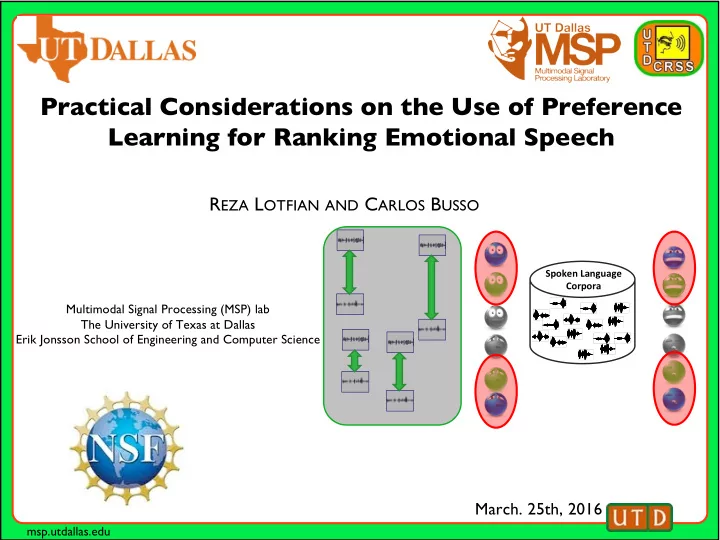

Practical Considerations on the Use of Preference Learning for Ranking Emotional Speech R EZA L OTFIAN AND C ARLOS B USSO Spoken Language Corpora Multimodal Signal Processing (MSP) lab The University of Texas at Dallas Erik Jonsson School of Engineering and Computer Science March. 25th, 2016 msp.utdallas.edu
Motivation • Creating emotions aware human computer interaction • Binary or multi-class speech emotion classification • Preference learning offers an appealing alternative • Widely explored in images, music, video, text • Few studies on preference learning for emotion recognition • Emotion retrieval from speech • Call centers • Healthcare applications 2 msp.utdallas.edu
Definition of the problem • Binary/multiclass classification versus preference learning • Binary class: training samples • low or high arousal? • Preference learning: training samples • Is the arousal level of sample1 higher than arousal level of sample2 ? Preference learning Binary problem Arousal Arousal Valence Valence msp.utdallas.edu 3
Definition of the problem • Absolute ratings of the emotions are noisy Arousal • Binary problem • Valence Remove samples close to boundary of different classes • Preference learning Arousal → • Questions Valence • How many samples are available for training? • How reliable are the labels? • What are the optimum parameters? (margin + size of training set) • How does it compare to alternative methods? msp.utdallas.edu 4
SEMAINE database User • Emotionally colored machine-human interaction • Sensitive artificial listener framework • Only solid SAL used (operator was played with Operator another human) • 91 sessions, 18 subjects (user) • Time-continuous dimensional labels • Annotated by FEELTRACE • We focus on arousal and valence dimensions Arousal (a) msp.utdallas.edu 5
Acoustic features • Speaker state challenge feature set at INTERSPEECH 2013 • 6308 high level descriptors • OpenSMILE toolkit • Feature selection (separate for arousal and valence) • Step 1: 6308 → 500 • Information gain separating binary labels (e.g., low vs high arousal) • Step 2: 500 → 50 • Floating forward feature selection • Maximizing the precision of retrieving 10% top and 10% bottom msp.utdallas.edu 6
How many samples are available for training? • Applying thresholds increases the reliability of training labels • Removing ambiguous labels • Larger margin: + more reliable labels - less samples for training Valence • How does different margins affect available training samples in binary and pairwise problems? msp.utdallas.edu 7
How many samples are available for training? • Binary labels • Pairwise labels Proportion of potential Samples included in pairwise comparisons training/testing sets included in training Samples included in testing sets binary classification Valence msp.utdallas.edu 8
How many samples are available for training? • Binary labels • Pairwise labels Valence msp.utdallas.edu 9
How many samples are available for training? • Binary labels • Pairwise labels Valence msp.utdallas.edu 10
How many samples are available for training? • Binary labels • Pairwise labels Valence msp.utdallas.edu 11
How many samples are available for training? • Binary labels • Pairwise labels Valence msp.utdallas.edu 12
How many samples are available for training? • More samples remain in training set in pairwise classification Arousal Valence msp.utdallas.edu 13
How reliable are the labels? • Precision of subjective evaluations • Find the average of ratings for all evaluators except one • Compare his/her labels to aggregated score • Pairwise labels: higher agreement between subjective evaluations for different thresholds evaluations • Few sample for margin >0.7 lead to noisy binary labels Arousal Valence msp.utdallas.edu 14
What are the optimum parameters? • Rank SVM problem • and are feature vectors of pair 𝑗 where 𝑡↓ 1 is preferred over 𝑡↓ 2 : nonzero slack variable : soft margin variable • Testing: is preferred over if msp.utdallas.edu 15
Preference learning • Training samples • Speaker independent partitioning for • Development (feature selection): 8 randomly selected speakers • Cross validation: 5 speakers for training, 5 speakers for testing • Set of pairwise preferences (rankings of length 2) • Samples that satisfy the margin’s threshold are selected • Different sample size is evaluated msp.utdallas.edu 16
Measure of retrieval performance Precision Precision at K (P@K) • Speech samples ordered by Rank-SVM K[%] • Select K/2 samples from top, K/2 samples from bottom • Example: P@100 → binary classification Ordered speech samples • Success if the sample is in the right side • Black → high; Gray → bottom • We can compare this approach to other machine learning algorithm Valence Arousal msp.utdallas.edu 17
What are the optimum parameters? • Optimum margin threshold • Arousal → 0.5 • Valence → 0.4 sample size: 1000 5000 10000 Arousal Valence msp.utdallas.edu 18
What are the optimum parameters? • Optimum sample size • ~5000 sample size: 1000 5000 10000 Arousal Valence msp.utdallas.edu 19
How does it compare to alternative methods? • Support vector machine (SVM) → Binary classifiers • Support vector regression (SVR) → Regression Arousal Valence (P@100) Dimension Rank-SVM [%] SVR [%] SVM [%] Arousal 77.1 65.5 68.1 Valence 66.8 62.1 61.7 msp.utdallas.edu 20
Conclusion • Considerations in preference training for emotion retrieval • Trade-offs • Label reliability vs training size • Optimize the margin between emotion labels in training samples • Preference learning provides more reliable labels and larger training set • Preference learning has higher precision in retrieval • Higher performance in binary classification • 7% arousal • 5.1% valence msp.utdallas.edu 21
Thanks for your attention! Reza Lotfian Ph.D. Student Affective computing http://msp.utdallas.edu/ msp.utdallas.edu
Recommend
More recommend